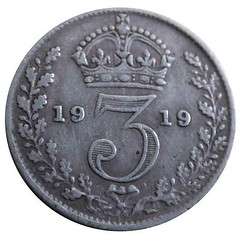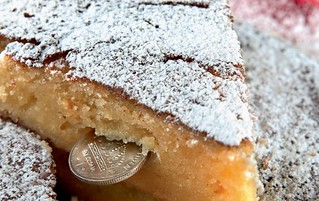
PREV ARTICLE
NEXT ARTICLE
FULL ISSUE
PREV FULL ISSUE
STIR-UP THREEPENNY PIECESDavid Pickup submitted this article on Stir-up Threepenny Pieces. I hadn't heard that particular term before. -Editor Stir-up Sunday is the last Sunday before the season of Advent. It gets its name from the beginning of the collect for the day in the Book of Common Prayer, which begins with the words, "Stir up, we beseech thee, O Lord, the wills of thy faithful people". It became associated with the custom of making the Christmas puddings on that day. Traditionally, families gather together in the kitchen of their homes to mix a Christmas pudding on Stir-up Sunday. Stir up, we beseech thee, O Lord, the wills of thy faithful people; that they, plenteously bringing forth the fruit of good works, may of thee be plenteously rewarded; through Jesus Christ our Lord. Amen.
On 25th December 1925 the Western Gazette reported that the Royal Mint normally issued more coins at Christmas. In past years silver threepences had been popular but that had declined because they turn a "bilious" (sickly) colour when cooked! Before 1920 coins contained 92.5% silver. Perhaps the colour change related to the reduced bullion content. Brass twelve sided threepence coins were started in 1937, and on 13th October 1937 the Evening Times of Dundee reported a Royal Mint official warning not to put any of new twelve sided threepences in Christmas puddings because possibility of poisoning or "flavoured puddings". I wonder what threepence flavour is like? I am not offering to find out! The custom has not died out. The Royal Mint and some coin dealers sell silver thrupenny bits. I have never found one. Perhaps a treat for numismatist would be to find a slabbed rare coin in their Christmas pudding.
Here's a related tradition - according to Wikipedia "Vasilopita is a New Year's Day bread or cake in Greece and many other areas in eastern Europe and the Balkans which contains a hidden coin or trinket which gives good luck to the receiver, like the Western European." -Editor
The Vasilopita is usually celebrated on New Year's Eve, but in many counties, it takes place on Christmas, and the end result is a beautiful family tradition, the Vasilopita it is actually a very flavorful cake rather than just a bread, it has a very interesting legacy, in that a lucky coin is baked right into it, and everyone knows this, anxiously waiting for that moment of who will find the coin in their piece, known to promise good fortune for the rest of the year. This year, the traditional "Cutting of the Vasilopita" will be as unusual as the upcoming Thanksgiving holiday, where normally, family and friends get together to celebrate their gratitude. In the age of Covid-19 and social distancing, many are understandably afraid, cautious, and bewildered. But one must think back into the history that has endured the survival of this 1,600-year tradition, where people still celebrated despite famine, disease, conflicts, and other difficult struggles, mainly because the human spirit is thankfully strong and unyielding. According to legend, in the ancient city of Caesarea in 300ad, lived a bishop named Basil, who later became a saint. When his city was under siege by a ruthless tyrant, Basil asked the people to help pay a ransom in order to save their city. The tyrant, humiliated by the total solidarity of the city's townspeople, finally reversed his position without taking the ransom. Saint Basil was now faced with the responsibility of how to return the valuables to the people. Facing a conclusion that was seemingly impossible for anyone to know what belonged to whom, he tasked the village bakers to make loaves of bread in which were placed their valuables, but the underlying miracle was that everyone received exactly what they had donated. The Vasilopita tradition, which continues to this day, is celebrated by Eastern Orthodox people around the world, in the United States, Greece, Eastern Europe, Albania, Bosnia, Bulgaria, Croatia, Kosovo, Montenegro, North Macedonia, Romania, Serbia, and Slovenia, where the family cuts the Vasilopita at midnight on the New Year's Eve to bless their house and to bring good luck.
To read the complete article, see:
A recipe for New Years Cake:
Wayne Homren, Editor The Numismatic Bibliomania Society is a non-profit organization promoting numismatic literature. See our web site at coinbooks.org. To submit items for publication in The E-Sylum, write to the Editor at this address: whomren@gmail.com To subscribe go to: https://my.binhost.com/lists/listinfo/esylum All Rights Reserved. NBS Home Page Contact the NBS webmaster 
|

